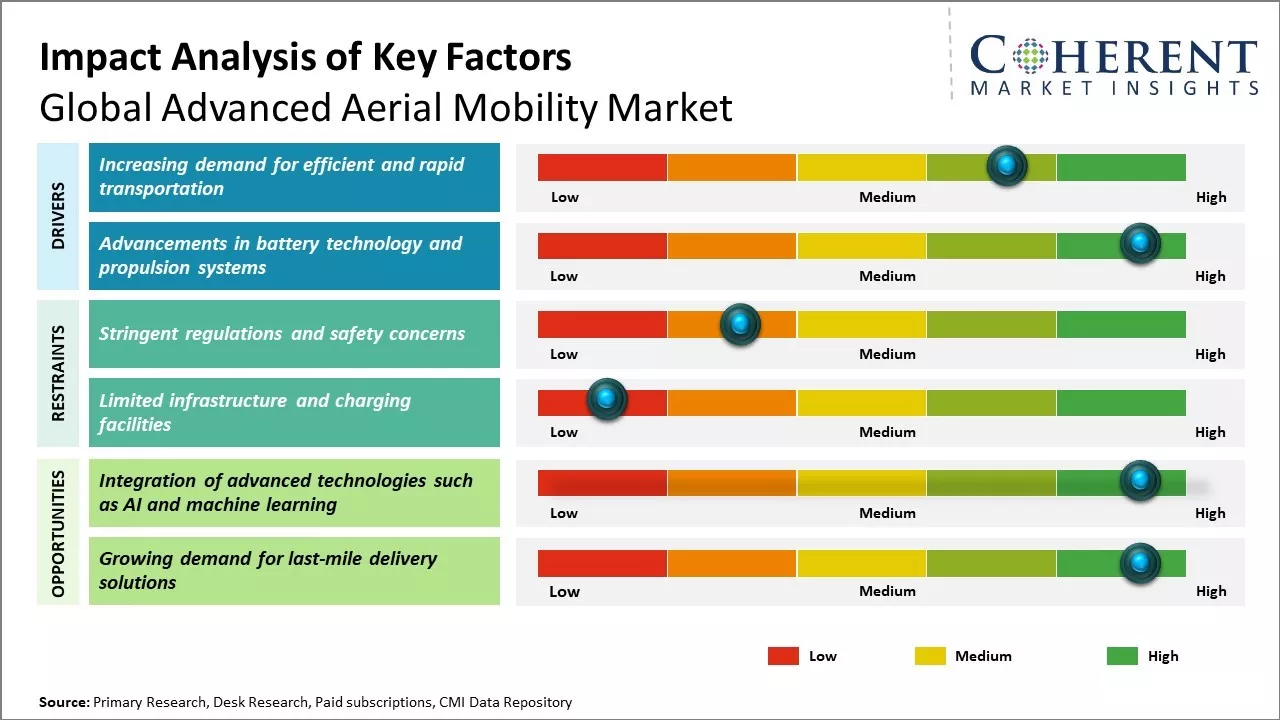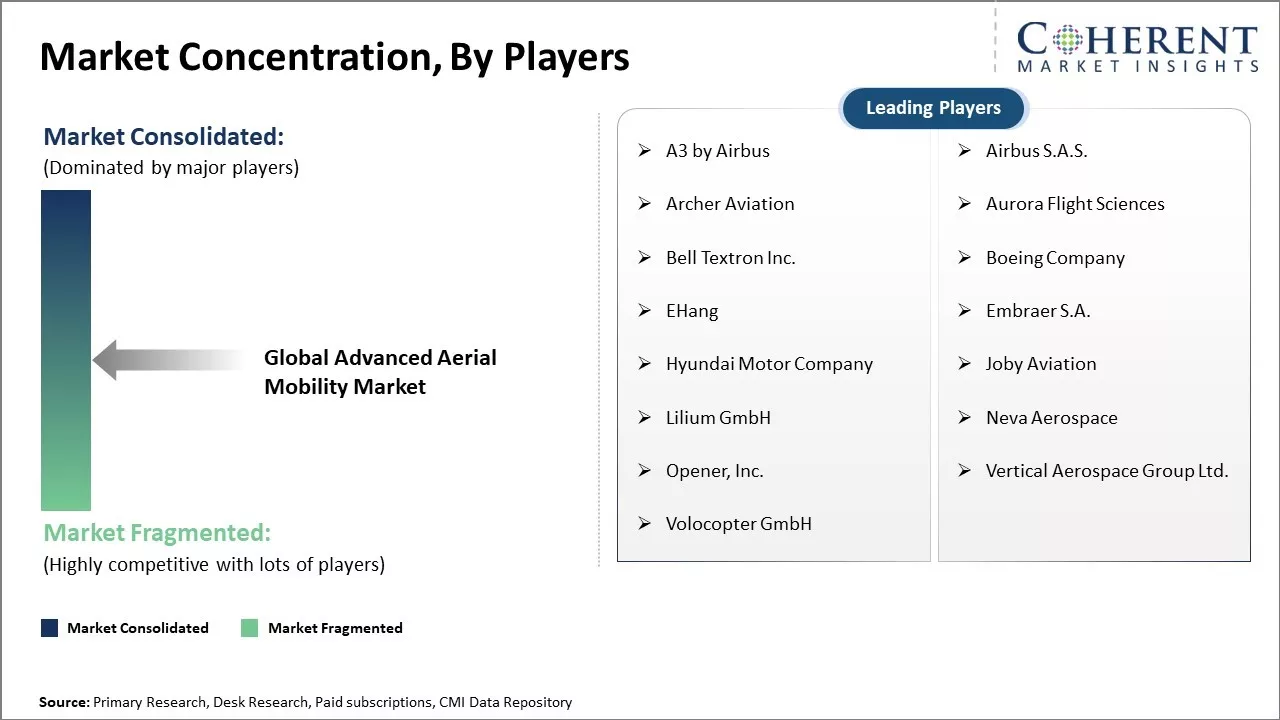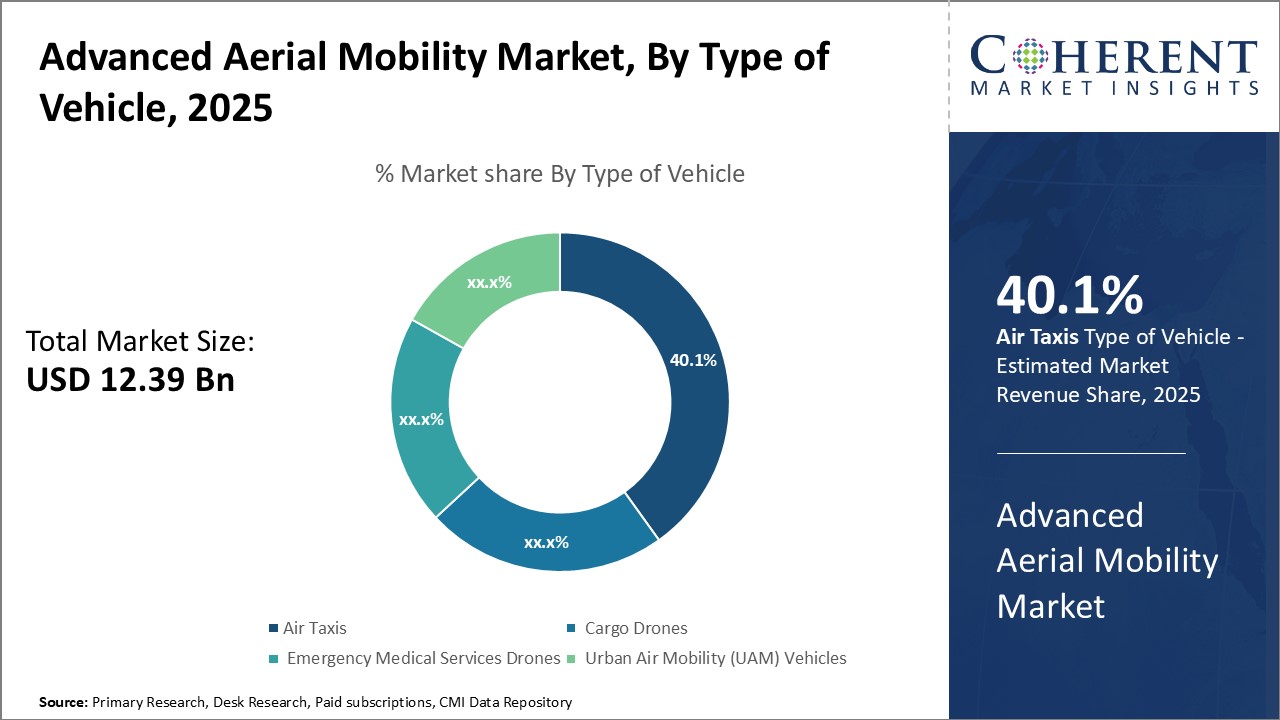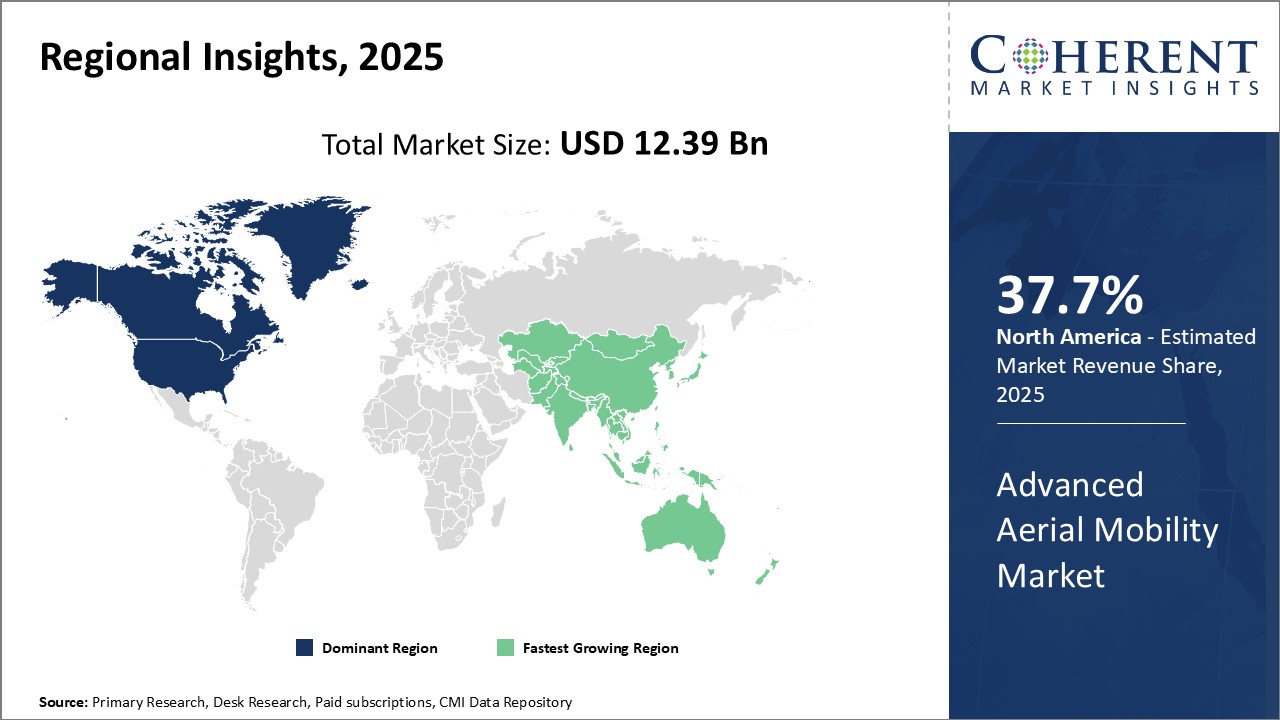Advanced Aerial Mobility Market Size and Trends
Global advanced aerial mobility market is estimated to be valued at USD 12.39 Bn in 2025 and is expected to reach USD 47.08 Bn by 2032, exhibiting a compound annual growth rate (CAGR) of 21.0% from 2025 to 2032.

Discover market dynamics shaping the industry: Download Free Sample
Advanced aerial mobility involves the deployment of urban air mobility vehicles for transporting passengers or cargo. Factors, such as increasing global traffic congestion, need for faster modes of transportation, and technological advancements in aerial vehicles, are fueling the demand for urban air mobility solutions. Companies such as Archer Aviation, Aurora Flight Sciences, Bell Textron Inc., Boeing Company, etc. are investing in the development of electric vertical take-off and landing (eVTOL) vehicles to enable quick point-to-point air transportation within cities. Ongoing pilot projects, favorable regulations, and declining battery costs are likely to boost the commercialization of advanced aerial vehicles during the forecast period. However, threats such as high solution costs, safety concerns, and infrastructural challenges remains major restraints for the market.
Increasing demand for efficient and rapid transportation
The continuous growth of urban population across major countries like Canada, Japan, U.S., etc. has led to rising traffic congestion and longer commute times. The infrastructure in most cities is already facing challenges in coping with the growing vehicle fleet size. Building new roads and highways requires huge investments and space which is becoming scarce in dense urban environments.
At the same time, there is a growing need for instant, flexible and seamless transport solutions between different locations within a city. The current modes of public transportation like metros and buses have limitations in terms of flexibility of routes and last-mile connectivity. Traditional modes of air transportation like helicopters are expensive and not scalable. This is where advanced aerial vehicles like eVTOL and cargo drones have a huge potential to resolve these problems and efficiency fill the gaps. Offering point-to-point, three-dimensional mobility, these new vehicles can reduce congestion, cut travel times and open up new possibilities for instant delivery of goods.
In December 2020, Joby Aviation, a U.S.-based aerospace company developing an all-electric vertical take-off and landing aircraft for a fast, quiet and affordable air taxi service, acquired Uber Elevate, Uber's urban air mobility initiative. The acquisition allowed Joby Aviation, which has raised US$ 820 million in investment and employs more than 500 people, to incorporate Uber Elevate's expertise in air mobility services and expand its presence in the urban air transportation market.
Market Concentration and Competitive Landscape

Get actionable strategies to beat competition: Download Free Sample
Advancements in battery technology and propulsion systems
One of the biggest constraints towards the large-scale adoption of advanced aerial vehicles has been limitations of existing battery and propulsion technologies. Helicopters and small planes require jet fuel or kerosene which are hazardous to handle and need additional fueling infrastructures. Hence, aerial vehicles like eVTOL have been designed to use electricity stored in lightweight, high energy density batteries for propulsion. However, current battery capacities are still insufficient for providing long range at reasonable vehicle weights. Similarly, propeller-based distributed electric systems lack sufficient power density for vertical take-off and landing as well as swift horizontal flight.
But the field of advanced batteries and electric propulsion has been progressing at a relentless pace driven by electric aviation as well as surging demand from electric vehicles on roads. Nanotechnology, materials science, and battery chemistries are under deep research worldwide to develop battery packs that can store much higher energy levels safely while retaining excellent power output characteristics during flight and landing. At the same time, companies are innovating propulsion system designs leveraging technologies such as distributed electric propellers, ducted fans, and advanced motors that enhance vehicle range, agility, and efficiency.
Key Takeaways from Analyst:
Decreasing costs of electric vertical take-off and landing (eVTOL) vehicles and increasing investment in urban air mobility (UAM) startups will boost market adoption. Rising urbanization and traffic congestion issues are prompting many cities to explore advanced aerial mobility as a viable transportation option.
Developing comprehensive safety standards for unmanned and autonomous flight will take time. Public acceptance is another challenge considering privacy and security concerns. High system costs and lack of necessary supporting infrastructure can slow initial deployments. Aviation agencies have to establish airspace management protocols as well for mixed operations.
North America is currently at the forefront of development, primarily due to substantial startup funding and the presence of technology clusters. Numerous pilot programs are being implemented in major cities to demonstrate both commercial and technical feasibility. Meanwhile, the Asia Pacific region is emerging as a significant market, driven by increasing traffic challenges in large metropolitan areas. China, in particular, is vigorously promoting research in advanced aerial mobility.
Market Challenge - Stringent regulations and safety concerns
Stringent regulations imposed by aviation regulatory bodies around the globe poses a significant challenge for the growth of global advanced aerial mobility market. Considering advanced aircrafts would carry passengers, stringent rules are being drafted to ensure highest level of safety. However, developing and complying with new regulations requires substantial investment of time and resources from manufacturers. Further, new technologies being used such as electric propulsion and autonomous operations raise safety concerns. All these new concepts would require rigorous testing and certification before being allowed for commercial passenger drone services. Establishing global standards for urban air mobility will be a lengthy process. Meanwhile, limited testing is allowed only under supervised conditions in select few regions. Overall, balancing strong safety measures with fast innovation and accessibility is a dilemma facing the industry.
Market Opportunity - Integration of advanced technologies such as AI and machine learning
The integration of advanced technologies such as artificial intelligence and machine learning offers huge potential for the global advanced aerial mobility market. AI-powered computer vision and sensor fusion can enable autonomous flight capabilities. Machine learning algorithms can help drones navigate crowded airspaces safely. It can also assist in functions such as obstacle avoidance, collision prevention, abnormal condition detection and emergency landing. The integration of AI brings opportunities to simulate complex scenarios for training autonomous flight systems. This reduces reliance on physical test flights and helps comply with stringent regulations. Data collected from drone operations can be leveraged for continuous improvement of AI models. The synergy between AI/ML and urban air mobility is paving the way for more autonomous, intelligent and safe advanced aircraft of the future.

Discover high revenue pocket segments and roadmap to it: Download Free Sample
Insights By Type of Vehicle - Convenience and Comfort Drive Demand for Air Taxis
In terms of type of vehicle, air taxis is expected to contribute 40.1% share of the market in 2025 owing to their convenience and comfort. Air taxis provide door-to-door transportation without the hassle of traffic or long transit times. This makes them very appealing for both business and leisure travel within urban regions. Passengers can travel directly from their point of origin like an office, home or hotel to their final destination without any stops or transfers. This saves considerable time as compared to ground transportation options which often involve dealing with traffic jams and delays.
Air taxis also offer a more comfortable travel experience. Passengers can sit back and enjoy a smooth ride high above traffic without any bumps or congestion issues faced on roads. The aerial view provides a scenic and relaxing atmosphere. Multiple operators are working to develop sleek and stylish aircraft designs for air taxis that prioritize passenger comfort with plush seating, leg room and in-flight connectivity options. This premium experience at affordable cost is driving the demand among high spending customers.
Convenience is a big factor especially in dense urban centers where time is precious. Air taxis allow covering long distances within cities much faster as the crow flies. This makes them suitable for busy executives needing to attend multiple meetings or events in a single day spread across a metro region. It also appeals to tourists who want to cover major attractions efficiently without wasting hours in transportation. The flexible point-to-point operations without fixed routes enhances their appeal.
Insights By Technology - Technological Superiority Boosts eVTOL Aircraft Segment
In terms of technology, the Electric Vertical Takeoff and Landing (eVTOL) segment contributes the 51.8% share in 2025 owing to its technological superiority over alternatives. eVTOL aircraft are fully electric-powered which makes them more efficient and eco-friendlier compared to hybrid options involving combustion engines. They produce zero emissions, helping aviation minimize its carbon footprint. This appeals to environmentally conscious consumers and supports regulations towards greener transportation.
Electric propulsion also provides advantages in operations. eVTOL vehicles have simpler mechanical designs without transmission systems since power comes directly from batteries. This makes them reliable and easy to maintain with minimal moving parts. Electronic controls further enhance safety and flight stability compared to mechanical linkages. Electric motors instantaneously regulate power precisely to independently operated rotors for vertical takeoff and landing as well as cruise phases of flight.
Advanced battery technologies are powering longer flight ranges for eVTOL aircraft. Some designs are targeting over 100 miles on a single charge which is sufficient for intra-city air taxi services. Utilizing thin-film lithium-ion or solid-state batteries, manufacturers are continuously improving energy densities to achieve parity with fossil fuels. Additionally, a global focus on developing sustainable battery technologies will soon bring down costs to affordable levels.
The regulatory environment is also more conducive for electric aircraft. Regulators prefer promoting clean technologies and several countries have proposed electric-only zones in cities. Overall, the emerging eVTOL segment leverages technological leadership to dominate advanced aerial mobility solutions of the future.
Insights By Application - Passenger Transport Drives Cargo Transportation Segment
In terms of application, passenger transportation contributes 38% share in 2025 as advancing autonomy reduces operating costs for viable commercial services. Passengers are eagerly waiting to experience novel mobility options unleashed by advanced aircraft designs. Early adopters are willing to pay higher fares for the privilege of being among the first to ride in the new air taxis. This allows operators to achieve necessary scale and utilize aircraft capacity for multiple revenue generating flights daily.
As passenger volumes rise, operators can commercialize larger capacity vehicles and run frequent, scheduled services between major traffic corridors within cities. With hundreds or thousands of daily passengers, costs per air-mile will decrease rapidly. This would bring fares at parity or potentially even lower than existing transit modes. While initial runs maybe limited to a few busy routes, expanded networks serve more origins and destinations over time.
New infrastructure like vertiports and advanced traffic management systems necessary for passenger services will simultaneously boost cargo capabilities. Spare capacity on passenger aircraft can carry express packages and goods during off-peak hours. Similarly, dedicated cargo drones provide overnight and same-day delivery of small shipments to enable e-commerce applications. As passenger services demonstrate market viability of UAM networks, complimentary cargo operations utilize existing infrastructure and flight routes for additional revenues and higher asset utilization of advanced aircraft.
Enhanced logistics capabilities will transform supply chains globally. Time-critical medical supplies can reach hospitals faster. Disaster relief aid as well as supplies to remote community’s access markets beyond existing ground limitations. Cargo operations thus evolve from early experimentation into a larger segment riding the coattails of successful passenger transportation services. Their shared infrastructure achieves the necessary scale effects to drive down overall sector costs.
Regional Insights

Need a Different Region or Segment? Download Free Sample
North America is currently dominating the global advanced aerial mobility market. The region is expected to hold 37.7% of the market share in 2025 due to strong governmental support. Countries like the U.S. and Canada have allocated huge funds for developing infrastructure and regulatory framework necessary for urban air mobility. With the U.S. being the global pioneer in aerospace technologies, most leading drone manufacturers and air taxi service providers, such as Boeing, Airbus, Joby, Bell, and Kitty Hawk, are headquartered in the region providing it an edge. For instance, in September 2022, the U.S. Economic Development Administration (EDA) awarded approximately US$ 40 million to organizations involved in developing the Tulsa Regional Advanced Mobility (TRAM) Corridor.
On the other hand, Asia Pacific region is poised to be the fastest growing market during the forecast period. Countries like China, Japan, and South Korea are aggressively investing in emerging technologies. Chinese EV makers like Xpeng and EHang are at forefront of developing electric air vehicles with capabilities of vertical take-off and landing. Further, urban congestions in major Asian cities such as Tokyo, Beijing, Manila, etc. have fueled the demand for innovative urban transportation alternatives. The regional authorities are increasingly supporting commercialization of aerial vehicles citing their immense potential in improving intra-city connectivity.
Europe is another major market for advanced aerial mobility driven by strong manufacturing base and innovation capabilities. Many European OEMs have proactively rolled out pilot air taxi services in global partnerships. Governments in countries like Germany and the U.K. are funding R&D projects and startups contributing to European market growth. Overall, with pro-business regulations and high disposable income levels, the European Advanced Aerial Mobility market is expected to emerge as lucrative for Advanced Aerial Mobility market over mid to long term.
Market Report Scope
Advanced Aerial Mobility Market Report Coverage
| Report Coverage | Details | ||
|---|---|---|---|
| Base Year: | 2024 | Market Size in 2025: | USD 12.39 Bn |
| Historical Data for: | 2020 To 2024 | Forecast Period: | 2025 To 2032 |
| Forecast Period 2025 to 2032 CAGR: | 21.0% | 2032 Value Projection: | USD 47.08 Bn |
| Geographies covered: |
|
||
| Segments covered: |
|
||
| Companies covered: |
A3 by Airbus, Airbus S.A.S., Archer Aviation, Aurora Flight Sciences, Bell Textron Inc., Boeing Company, EHang, Embraer S.A., Hyundai Motor Company, Joby Aviation, Lilium GmbH, Neva Aerospace, Opener, Inc., Vertical Aerospace Group Ltd., and Volocopter GmbH |
||
| Growth Drivers: |
|
||
| Restraints & Challenges: |
|
||
Uncover macros and micros vetted on 75+ parameters: Get instant access to report
Market Segmentation
- By Type of Vehicle Insights (Revenue, USD Bn, 2020 - 2032)
- Air Taxis
- Cargo Drones
- Emergency Medical Services (EMS) Drones
- Urban Air Mobility (UAM) Vehicles
- By Technology Insights (Revenue, USD Bn, 2020 - 2032)
- Electric Vertical Takeoff and Landing (eVTOL)
- Hybrid VTOL
- Traditional Aviation
- By Application Insights (Revenue, USD Bn, 2020 - 2032)
- Passenger Transportation
- Cargo Transportation
- Surveillance and Monitoring
- Emergency Services
- Agriculture
- Regional Insights (Revenue, USD Bn, 2020 - 2032)
- North America
- U.S.
- Canada
- Latin America
- Brazil
- Argentina
- Mexico
- Rest of Latin America
- Europe
- Germany
- U.K.
- Spain
- France
- Italy
- Russia
- Rest of Europe
- Asia Pacific
- China
- India
- Japan
- Australia
- South Korea
- ASEAN
- Rest of Asia Pacific
- Middle East
- GCC Countries
- Israel
- Rest of Middle East
- Africa
- South Africa
- North Africa
- Central Africa
- North America
- Key Players Insights
- A3 by Airbus
- Airbus S.A.S.
- Archer Aviation
- Aurora Flight Sciences
- Bell Textron Inc.
- Boeing Company
- EHang
- Embraer S.A.
- Hyundai Motor Company
- Joby Aviation
- Lilium GmbH
- Neva Aerospace
- Opener, Inc.
- Vertical Aerospace Group Ltd.
- Volocopter GmbH
Share
Share
About Author
Suraj Bhanudas Jagtap is a seasoned Senior Management Consultant with over 7 years of experience. He has served Fortune 500 companies and startups, helping clients with cross broader expansion and market entry access strategies. He has played significant role in offering strategic viewpoints and actionable insights for various client’s projects including demand analysis, and competitive analysis, identifying right channel partner among others.
Missing comfort of reading report in your local language? Find your preferred language :
Transform your Strategy with Exclusive Trending Reports :
Frequently Asked Questions
EXISTING CLIENTELE
Joining thousands of companies around the world committed to making the Excellent Business Solutions.
View All Our Clients
